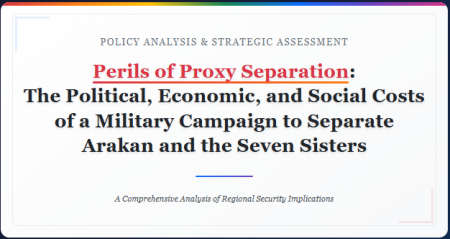| নির্বাচিত পোস্ট | লগইন | রেজিস্ট্রেশন করুন | রিফ্রেস |
 রেজাউল করিম ফকির
রেজাউল করিম ফকির
অধ্যাপক, কোবে গাকুইন বিশ্ববিদ্যালয়
 Introduction
Introduction
Efforts to foster or exploit separatist movements across international borders are never purely local affairs. When domestic political actors seek to influence the fate of neighboring regions — especially through armed means — they expose their country to complex international dynamics and layered long-term risks. The scenario outlined above, in which a domestic political faction (the Touhidi Janata) and associated deep-state actors aim to back independence for Arakan (Rakhine) and India’s “Seven Sisters” (the northeastern states) with external military aid, illustrates how quickly strategic choices can cascade into catastrophic political, economic, and social outcomes for the sponsor state. This essay examines those likely consequences, catalogues the mechanisms of damage, and highlights why the costs far outweigh any plausible short-term gains.
Strategic and military consequences
A military campaign aimed at detaching territories from Myanmar and India would immediately internationalize the conflict. India and Myanmar would almost certainly interpret such support as direct interference in their territorial integrity and respond with military countermeasures. The likely theatre of hostilities would extend beyond contested border areas to strategic infrastructure: highways, bridges, communications hubs, power plants, airports, and seaports. Destruction or disruption of these nodes would degrade the sponsor state’s operational mobility and sever vital economic arteries, crippling the state’s ability to respond or sustain prolonged operations.
Moreover, reliance on external powers for arms, logistics, and financing introduces dependencies that can become instruments of coercion. Foreign military aid often comes with strings — basing rights, access to resource concessions, and influence over defense and diplomatic policy. Once a conflict becomes protracted, foreign allies may insist on permanent facilities to “protect” their personnel and investments, evolving from temporary wartime presence to enduring strategic footholds. Such footholds enable external actors to shape domestic politics and foreign policy long after active hostilities subside.
Economic costs and debt traps
War is expensive. Immediate expenditures include mobilization, procurement of weapons, fuel and ammunition, intelligence and communications systems, medical and logistical support, and reconstruction. For a developing economy, these costs are typically financed through external borrowing and conditional assistance. If the principal financiers are powerful states whose strategic objectives extend beyond mere support (for example, access to minerals or geopolitical positioning), the terms can be predatory. Debt incurred to finance wartime operations — especially under duress — risks transformation into economic concessions: long-term leases of natural-resource extraction rights, privatization of state assets under foreign management, or direct transfers of ownership of mineral reserves.
Even absent explicit legal transfer, the leverage created by large, unrecoverable debts allows creditors to impose policies that favor their access to resources and influence over domestic governance. Over time, this dynamic can hollow out sovereignty: fiscal space shrinks, public investment is crowded out by debt servicing, and economic policy becomes oriented to satisfy external stakeholders rather than national development.
Social and cultural damage
Armed conflict and infrastructure attacks produce immediate humanitarian crises — displacement, casualties, lost livelihoods, and interrupted education and healthcare — with long tails of trauma, social fragmentation, and demographic change. Targeted or generalized displacement alters social composition and local economies; refugee flows strain neighboring regions and can generate internal political instability. Cultural institutions — schools, museums, places of worship — may be damaged or lose funding, attenuating cultural transmission and civic cohesion. Militarization of society fosters normalization of violence, weakens civil institutions, and empowers actors who profit from insecurity.
Political and institutional erosion
The political fallout from inviting foreign military power onto sovereign soil is substantial. Once foreign bases and advisory roles become entrenched, domestic political elites may find themselves constrained by the priorities of host powers. Security services and armed forces that receive training, equipment, and funding from external patrons may align their doctrines and institutional loyalties accordingly, undermining civilian oversight and national accountability. Political pluralism suffers as patronage networks realign toward externally backed actors; policies that previously would have been determined domestically are subject to negotiation with foreign stakeholders.
Long-term sovereignty risks
Taken together, infrastructure destruction, economic indebtedness, social fragmentation, and institutional capture produce enduring limitations on sovereignty. The rhetorical promise that “separatist success” will yield territorial or diplomatic gains for the sponsor state becomes hollow if the same process yields foreign-controlled resources, permanent foreign bases, and subordinated policy-making. In short, the cost of a short-term geopolitical gambit can be permanent loss of autonomy.
Conclusion and prudent alternatives
The scenario of supporting separatist movements through external military backing is fraught with existential risks. Rather than pursue high-risk military adventurism, prudent policy options include: robust diplomacy that respects international law; conflict-avoidance measures and confidence-building with neighbors; investment in domestic resilience (infrastructure redundancy, diversified supply chains, and credible defense without external dependency); and multilateral engagement to address grievances driving cross-border instability (development aid, cross-border economic integration, and people-to-people ties). These alternatives preserve sovereignty, reduce the prospect of costly foreign dependencies, and create sustainable pathways for influence that do not invite the very harms sketched above.
Any policy that contemplates armed efforts to alter neighboring borders must be weighed against not only immediate military feasibility but also the profound, multi-dimensional costs that will likely follow — costs that may irreversibly impair the nation’s political independence, economic health, and social fabric.
©somewhere in net ltd.